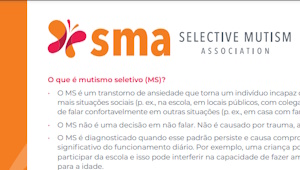Online Library
Functional Behavioral Assessment Overview for Parents
Functional Behavioral Assessment
Why are children selectively mute? This is a critical question and the answers will be different for different children. Answering the question for your child requires a team effort to do a Functional Behavioral Assessment, also called an FBA. The team must include the parent, a trained behavior specialist, such as a psychologist or a behavior analyst (also known as a BCBA), teachers, administrators, and others who work with the student. The goal of the FBA is to gather data, much like a detective, to help figure out why a particular student is engaging in the target behavior, such as nonverbal behavior, or other socially avoidant behaviors, and to begin generating ideas of how to replace the problematic or impairing behaviors with more productive, engaging behaviors.
How to Conduct a FBA
There are several key steps in a conducting an FBA:
1. Defining the behavior: The team needs to define the concerning behaviors in very specific terms, such as, limits responding to nods of the head, pointing, and gesturing, limits responses to preferred peers to whispers, or when prompted to answer in a small group the student avoids a verbal response. FBAs are commonly a first step in understanding a student’s individual needs. FBAs may be conducted as part of an evaluation to consider a student for special education, for students who already have Individualized Education Plans (IEPs), or as part of developing and implementing a 504 Plan.
2. Gathering specifics: The team gathers as much data as possible about when, where, with whom, and with what frequency or intensity these concerning behaviors happen. As parents and teachers well know, students with SM vary greatly in how much or little they are able to engage depending on the specifics of the circumstances. That is SM by definition! The FBA should always include live behavioral observations in addition to review of all data from several sources, e.g., report cards, talking with prior teachers, watching home videos if provided.
3. Generating hypotheses about the functions of the behavior: FBAs are rooted in the idea that behaviors happen, or don’t happen, for functional reasons. If a child is overwhelmed with anticipatory anxiety about saying the wrong thing, or fear their voice sounds funny, or worry that children will over-react when they do speak, they may then continue to avoid speaking. Avoidance of anxiety is thought to be a key maintaining variable for students with SM.
4. Behavioral Plan: Based on these educated guesses about why the student is unable to speak in certain situations, the team will generate an initial behavioral plan, sometimes referred to as a BIP – Behavior Intervention Plan. This plan will take into account gradually and systematically shaping, or building up, the student’s ability to speak and otherwise engage in some low avoidance situations before moving onto more avoidance-provoking situations. Generally, some carefully planned small rewards will be built into the BIP to reinforce the new behaviors. The team will meet periodically to re-evaluate if the hypotheses were supported and if the plan is actually working.
With careful analysis, the team can find positive, workable solutions that will, over time, reduce impairing behaviors and replace them with more adaptive alternative behaviors. The FBA and subsequent BIP allow your child or student to benefit as much as possible from a Free, Appropriate Public Education – this is known as FAPE in the educational law and it’s afforded to all students under Federal law.




